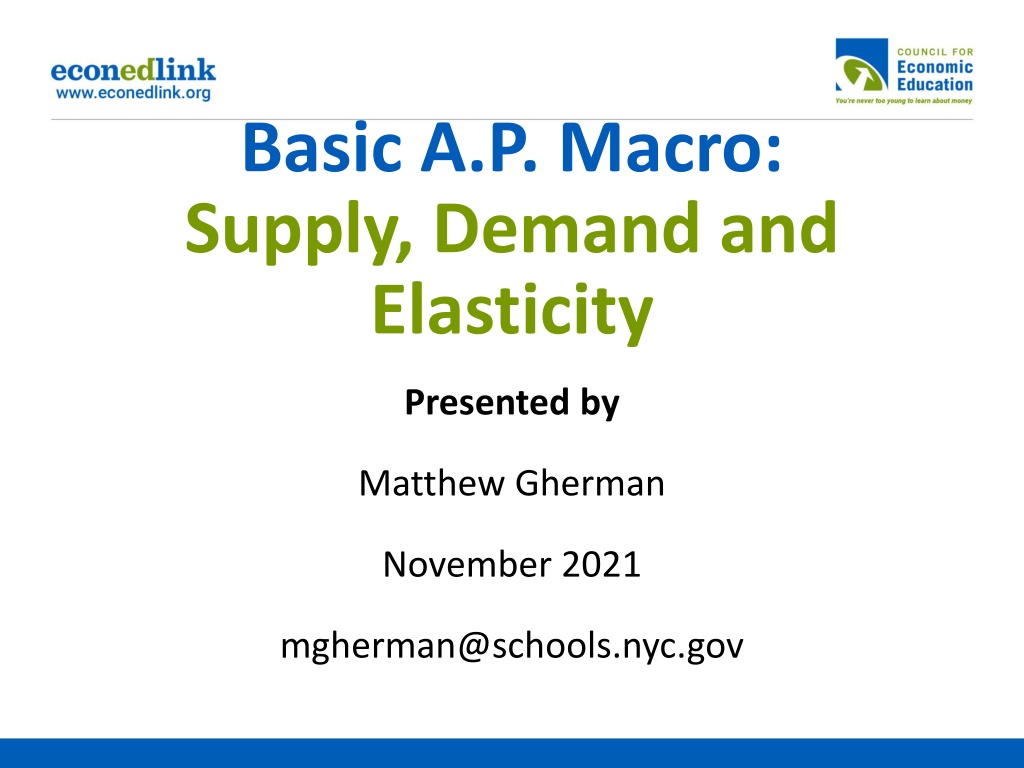
Teaching the Laws of Supply and Demand in Economics
Explore how to effectively teach the fundamental principles of supply and demand along with elasticity in economics. Gain insights into engaging students, graphing tips, and providing handouts. Learn about market prices, demand and supply dynamics, and their impact on relative prices. This session also covers national and state standards in economics education.
Uploaded on | 0 Views
Download Presentation

Please find below an Image/Link to download the presentation.
The content on the website is provided AS IS for your information and personal use only. It may not be sold, licensed, or shared on other websites without obtaining consent from the author. If you encounter any issues during the download, it is possible that the publisher has removed the file from their server.
You are allowed to download the files provided on this website for personal or commercial use, subject to the condition that they are used lawfully. All files are the property of their respective owners.
The content on the website is provided AS IS for your information and personal use only. It may not be sold, licensed, or shared on other websites without obtaining consent from the author.
E N D
Presentation Transcript
Basic A.P. Macro: Supply, Demand and Elasticity Presented by Matthew Gherman November 2021 mgherman@schools.nyc.gov
EconEdLink Membership You can now access CEE s professional development webinars directly on EconEdLink.org! To receive these new professional development benefits, become an EconEdLink member. As a member, you will now be able to: Automatically receive a professional development certificate via e-mail within 24 hours after viewing any webinar for a minimum of 45 minutes Register for upcoming webinars with a simple one-click process Easily download presentations, lesson plan materials, and activities for each webinar Search and view all webinars at your convenience Save webinars to your EconEdLink dashboard for easy access to the event You may access our new Professional Development page here
Professional Development Certificate To earn your professional development certificate for this webinar, you must: Watch a minimum of 45-minutes and you will automatically receive a professional development certificate via e-mail within 24 hours. Accessing resources: You can now easily download presentations, lesson plan materials, and activities for each webinar from EconEdLink.org/professional- development/
Agenda Today we will be going through how to teach the laws of Supply and Demand, and Elasticity of Demand.
Objectives - Opening Discussions for student engagement - The laws of Supply and Demand - Graphing tips! - Handouts for students
National Standards 7.1 Market prices are determined through the buying and selling decisions made by buyers and sellers. 7.2 The term relative price refers to the price of one good or service compared to the prices of other goods and services. Relative prices are the basic measures of the relative scarcity of products when prices are set by market forces (supply and demand). 8.1 Demand for a product changes when there is a change in consumers incomes, preferences, the prices of related products, or in the number of consumers in a market. 8.2. Supply of a product changes when there are changes in either the prices of the productive resources used to make the product, the technology used to make the product, the profit opportunities available to producers from selling other products, or the number of sellers in a market. 8.3. Changes in supply or demand cause relative prices to change; in turn, buyers and sellers adjust their purchase and sales decisions.
State Standards 12.E2a Given that the resources of individuals (and societies) are limited, decisions as to what goods and services will be produced and to whom to sell one s resources are driven by numerous factors, including a desire to derive the maximum benefit from and thus the most efficient allocation of those resources. 12.E2b The choices of buyers and sellers in the marketplace determine supply and demand, market prices, allocation of scarce resources, and the goods and services that are produced. In a perfect world, consumers influence product availability and price through their purchasing. Product market supply and demand determine product availability and pricing. 12.E2c Businesses choose what to supply in the product market, based on product market prices, available technology, and prices of factors of production. The prices of those factors are determined based on supply and demand in the factor market. The supply and demand of each factor market is directly related to employment. Debates surround various ways to minimize unemployment (frictional, structural, cyclical).
What is the average slice of pizza in your neighborhood? Class survey how many people would buy a slice of pizza (everything else normal about the pizza etc) at $2.50 then go up to $5 and down to $1. Also ask, how many slices would you buy?
Price Pizza slices $5.00 $4.00 $3.00 $2.50 $2.00 $1.00
Seniors in our building sell candy to raise money for senior dues at $1.00 a candy bar Survey of how many people in class buy candy for $1 and how many bars do you buy a day? Create a schedule based on their answers
Just demonstrated the Law of Demand, specifically, law of quantity quantity demanded. demanded. quantity demanded is inversely proportional to price. Simply put, the higher the price, the lower the quantity demand; and the lower the price, the higher the quantity demand. Changes in the Quantity Demanded Changes in the Quantity Demanded -- change in the amount of a product demanded due only to a change in price only to a change in price. (because the quantity demanded is immediately affected by the price!)
*When prices change creating a change in quantity demanded, this is called a movement along the demand curve.
Now lets go back to the chocolate bars, what if you found out that the chocolate bars will raise your SAT score? At $1.00, how many of you would now be more willing and able willing and able to buy chocolate? Create a new schedule in comparison with the old schedule. Price Original Demand New Demand
What if you found out that the chocolate bars are unhealthy? At $1.00, how many of you would be willing and able willing and able to buy chocolate? Create a new schedule in comparison with the old schedule. Price Original Demand New Demand
Did price change in this example? Price Original Demand New Demand $1.00 20 35 This is called a Change in Demand. Change in Demand. When buyers are willing to buy more or less than before at the same price due to factors other than price the same price
Shift Right = Increase in ability and willingness Shift Left = Decrease in ability and willingness
T = tastes/preferences R = related products I = income of buyers B = buyers (number of) E = expectations of prices
Substitute Substitute Products Products that can be purchased in place of product x Products Complimentary Complimentary Products True Cost Products: Products that must be bought with product x Products Example: Orange Juice (product x) vs. Apple Juice (product y) What happens to demand for Orange Juice (x) when the price of Apple Juice changes? **Remember: the price of product x is NOT CHANGING in each example. Example: Product x = SUV s, product y = gasoline. What happens to Demand for Product x as price of gas (y) goes up/down?
Expectation of price to Expectation of price to decrease If the price of product x remains the same, but we expect the price to decrease in the near future, we will demand less of the product now. decrease Expectation of price to Expectation of price to increase If the price of product x remains the same, but we expect the price to increase in the near future, we will demand more of the product now. increase **Remember: the current price of product x is NOT CHANGING; we expect Its price to change in the future.
Complete pages 23-28 of Supply and Demand packet ***read carefully and follow all instructions completely!*** ***additional instructions: for multiple choice #4,5,6: use a graph to help you answer the questions (when in doubt, graph it out!)***
Motivation Motivation: : How many people sell chocolate bars to raise money for senior dues? Why do you? Why don t you? Introduction of input costs, total revenue, profit Input cost to buy chocolate box: $30. 60 bars in the box, can be sold for $1 each. Total revenue = $60 Break even = total revenue = input costs = $30 Profit potential = $30
Create a schedule: at $1, how many of you would sell chocolate? If people were willing to pay $2, how many of you would sell chocolate? Why did this go up? Your break even went down, now you only need to sell 15 bars to break even and your max profit increased to $45. Inversely, if you could only make $.75, your break even cost went up, and now it takes longer to profit for less profit. PRICE = PROFIT PRICE = PROFIT
These have all been changes in quantity supplied the amount supplied from the suppliers perspective increased/decreased only due to the change in price. If we plot the schedule, we see that as price increases, quantity supplied also increases and as price decreases, quantity supplied decreases.
Now lets think of the pizzeriawhat are the input costs (the costs of doing business)? Have kids brainstorm wages, insurance, rent, utilities, resources, etc. What happens the ability and willingness to supply if these input costs and resources change in price and availability?
Changes due to factors other than the market price. At the current market price, changes to these factors will cause suppliers to either be less or more willing and able to supply their products R R Resources (availability and cost of) O O other products related market products (televisions and gaming systems) T T -- taxes T T -- technology E E expectations of prices N N number of suppliers
Price = Profit If businesses expect future prices to increase, they will decrease Supply now to wait for higher prices If businesses expect future prices to decrease, they will supply more now to make the most profit. *Current price did not change, just the expectation of future prices.
Task: Complete pages 29-34 in your S and D packet. Make sure to read and follow all instructions before starting an activity For questions 4,5,6, make sure to include an explanation and when it doubt -- GRAPH IT OUT!
Equilibrium Price and Equilibrium Quantity Compare the schedules from the previous two days for either pizza or chocolate bars Price Quantity Demanded Quantity Supplied $4.00 25 90 $2.50 70 70 $1.00 90 25 Where do we see the ability and willingness of consumers to purchase and businesses to supply aligned?
Equilibrium/Market Price: The price at which supply and demand intersect demand intersect/are equal - a price that is established by the free market. Suppliers are willing and able willing and able to sell and consumers are willing and able willing and able to buy for this same price. (shown graphically as "p") (shown graphically as "p") supply and Equilibrium/Market Quantity: The quantity for which the supply and demand for a product are equal. The amount the suppliers are willing/able to produce, the amount, consumers are willing/able to purchase (shown graphically as "q") (shown graphically as "q")
1) Signal to consumers and producers 2) Answers WHO receives the goods and services? 3) Answers HOW they are produced (efficiently to break even)
When the government believes the market price is too low, they will create a Price Floor When the government believes the market price is too high, they will create a Price Ceiling.
What will happen to market price and quantity of pizza if new studies show that pizza is healthy? Step 1: One scenario = one perspective Step 2: Whose perspective is being affected? Step 3: How is that Ability and Willingness being affected? Step 4: When in doubt, graph it out!
e1 e
Simple version of Affordable Health Care Act: Let us take a look at how the market for health care has been affected by the American Affordable Health Care Act. Part of the act creates a voucher and subsidy system to increase the availability of health care to people. However, there are also increased regulations and taxes on health care companies and providers. What will be the effect on the market price and market quantity of health care?
1) Two scenarios = one demand and one supply 2) Identify each perspective 3) How is the ability and willingness of each perspective being affected 4) Graph EACH SEPARATELY 5) Identify what happens to price/quantity in each 6) One outcome will be predictable, the other will be pulled in two different directions by market forces and will be indeterminate and ambiguous indeterminate and ambiguous
Increase in Demand Decrease in Supply P increases P increases Q increases Q decreases
Motivation: How many people have Facebook? How many people have MetroCards? How many people would still have Facebook if they charged $5.00 a month How many people would still have a MetroCard if metro services went up to $5.00 a ride? What is the difference between the two products?
Consumer Sensitivity Consumer Sensitivity is a concept called Elasticity of Demand. Demand. It measures the sensitivity of consumption to a change of price. If a product is elastic elastic, then it is sensitive to change quantity demanded stretches as price stretches. If a product is inelastic inelastic, the quantity demanded does not change/stretch as much with the changing price. Elasticity of
1) When in doubt, graph it out! 2) Compare the % change in price to the % change in quantity demanded 3) Compare the % change in Total Revenue to the % change in price 4) Compare characteristics of goods/services
*Elastic *Elastic = Percentage change in quantity demanded greater than percentage change in price (divide %change in qty demanded by % change in price) - answer is greater than 1. answer is greater than 1. Or, the total revenue changes decrease and quantity demand change. decrease as the price *Inelastic *Inelastic = Percentage change in quantity demanded is less than percentage change in price (less than 1) (less than 1) Or, the total revenue increases change and decrease in quantity demand increases despite the price *Unit Elastic *Unit Elastic= = Percentage change in quantity demanded is a 1:1 ratio with the change in price - answer is equal to 1. Or, the total revenue remains the same same with the change in price and demand. emains the
Need or a want? -- Luxury Cross Price Elasticity -- substitutes? - Time Elasticity -- can purchase be forestalled? Income Elasticity -- does purchase take up a lot of income?
How do taxes affect elastic and inelastic industries? If the industry is inelastic, businesses can raise the price of their product because there will not be a dramatic decrease in quantity demanded; the tax incidence can be pushed down to the consumer. consumer. If the industry is elastic, businesses cannot raise the price of the product because there will be a dramatic decrease in quantity demanded, therefore the tax incidence falls on the business.
Assessment Questions 1) How do the laws of supply and demand affect your opinion on political issues such as taxes and regulations 2) How do the laws of elasticity affect your opinion on political issues such as taxes and regulations? 3) How do the laws of Supply and Demand affect your belief of where does the flow of the dollar start in the circular flow model? 4) How have these discussions affected your opinion on minimum wage? 5) How have these discussions affected your opinion on health care?
Assessment Questions AP Style A decrease in the price of silicon chips and increased production of user-friendly software will affect the price and quantity of computers in which of the following ways? a) price increase and quantity indeterminate b) price indeterminate and quantity decrease c) price decrease and quantity decrease d) price decrease and quantity indeterminate e) price indeterminate and quantity increase
Assessment Questions AP Style A production of automobiles and an decrease in consumer income will most likely cause the price and quantity of which of the following ways? depreciation in the technology used in the automobiles to change in Price Price Quantity Quantity a) indeterminate decrease b) increase indeterminate c) indeterminate indeterminate d) decrease indeterminate e) indeterminate increase






















